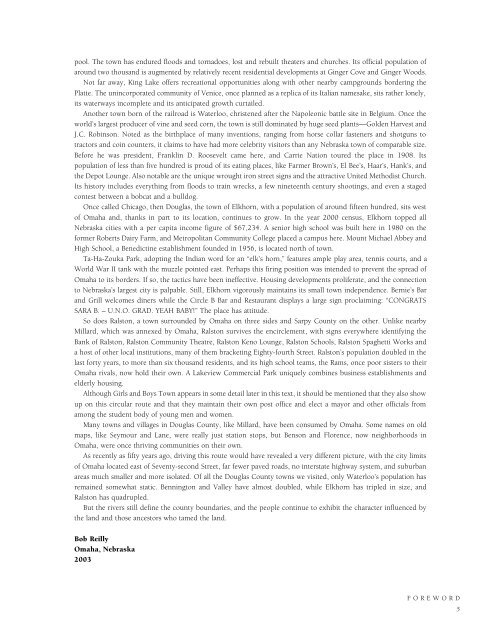Historic Omaha
An illustrated history of Omaha and the Douglas County area, paired with the histories of companies, families and organizations that make the region great.
An illustrated history of Omaha and the Douglas County area, paired with the histories of companies, families and organizations that make the region great.
Create successful ePaper yourself
Turn your PDF publications into a flip-book with our unique Google optimized e-Paper software.
pool. The town has endured floods and tornadoes, lost and rebuilt theaters and churches. Its official population of<br />
around two thousand is augmented by relatively recent residential developments at Ginger Cove and Ginger Woods.<br />
Not far away, King Lake offers recreational opportunities along with other nearby campgrounds bordering the<br />
Platte. The unincorporated community of Venice, once planned as a replica of its Italian namesake, sits rather lonely,<br />
its waterways incomplete and its anticipated growth curtailed.<br />
Another town born of the railroad is Waterloo, christened after the Napoleonic battle site in Belgium. Once the<br />
world’s largest producer of vine and seed corn, the town is still dominated by huge seed plants—Golden Harvest and<br />
J.C. Robinson. Noted as the birthplace of many inventions, ranging from horse collar fasteners and shotguns to<br />
tractors and coin counters, it claims to have had more celebrity visitors than any Nebraska town of comparable size.<br />
Before he was president, Franklin D. Roosevelt came here, and Carrie Nation toured the place in 1908. Its<br />
population of less than five hundred is proud of its eating places, like Farmer Brown’s, El Bee’s, Haar’s, Hank’s, and<br />
the Depot Lounge. Also notable are the unique wrought iron street signs and the attractive United Methodist Church.<br />
Its history includes everything from floods to train wrecks, a few nineteenth century shootings, and even a staged<br />
contest between a bobcat and a bulldog.<br />
Once called Chicago, then Douglas, the town of Elkhorn, with a population of around fifteen hundred, sits west<br />
of <strong>Omaha</strong> and, thanks in part to its location, continues to grow. In the year 2000 census, Elkhorn topped all<br />
Nebraska cities with a per capita income figure of $67,234. A senior high school was built here in 1980 on the<br />
former Roberts Dairy Farm, and Metropolitan Community College placed a campus here. Mount Michael Abbey and<br />
High School, a Benedictine establishment founded in 1956, is located north of town.<br />
Ta-Ha-Zouka Park, adopting the Indian word for an “elk’s horn,” features ample play area, tennis courts, and a<br />
World War II tank with the muzzle pointed east. Perhaps this firing position was intended to prevent the spread of<br />
<strong>Omaha</strong> to its borders. If so, the tactics have been ineffective. Housing developments proliferate, and the connection<br />
to Nebraska’s largest city is palpable. Still, Elkhorn vigorously maintains its small town independence. Bernie’s Bar<br />
and Grill welcomes diners while the Circle B Bar and Restaurant displays a large sign proclaiming: “CONGRATS<br />
SARA B. – U.N.O. GRAD. YEAH BABY!” The place has attitude.<br />
So does Ralston, a town surrounded by <strong>Omaha</strong> on three sides and Sarpy County on the other. Unlike nearby<br />
Millard, which was annexed by <strong>Omaha</strong>, Ralston survives the encirclement, with signs everywhere identifying the<br />
Bank of Ralston, Ralston Community Theatre, Ralston Keno Lounge, Ralston Schools, Ralston Spaghetti Works and<br />
a host of other local institutions, many of them bracketing Eighty-fourth Street. Ralston’s population doubled in the<br />
last forty years, to more than six thousand residents, and its high school teams, the Rams, once poor sisters to their<br />
<strong>Omaha</strong> rivals, now hold their own. A Lakeview Commercial Park uniquely combines business establishments and<br />
elderly housing.<br />
Although Girls and Boys Town appears in some detail later in this text, it should be mentioned that they also show<br />
up on this circular route and that they maintain their own post office and elect a mayor and other officials from<br />
among the student body of young men and women.<br />
Many towns and villages in Douglas County, like Millard, have been consumed by <strong>Omaha</strong>. Some names on old<br />
maps, like Seymour and Lane, were really just station stops, but Benson and Florence, now neighborhoods in<br />
<strong>Omaha</strong>, were once thriving communities on their own.<br />
As recently as fifty years ago, driving this route would have revealed a very different picture, with the city limits<br />
of <strong>Omaha</strong> located east of Seventy-second Street, far fewer paved roads, no interstate highway system, and suburban<br />
areas much smaller and more isolated. Of all the Douglas County towns we visited, only Waterloo’s population has<br />
remained somewhat static. Bennington and Valley have almost doubled, while Elkhorn has tripled in size, and<br />
Ralston has quadrupled.<br />
But the rivers still define the county boundaries, and the people continue to exhibit the character influenced by<br />
the land and those ancestors who tamed the land.<br />
Bob Reilly<br />
<strong>Omaha</strong>, Nebraska<br />
2003<br />
FOREWORD<br />
5
















